Lecture 12
Mathematical analysis
In this lection we will familiarize with tools of analysis referred to the mathematical method. These tools were obtained as a result of conducting of various mathematical actions with a market price and were named technical indicators of the market. Earlier indicators were calculated and put on the graph manually, but with computer techniques and programming development, computers began to do this work, and indicators are named as computer analysis tools in increasing frequency.
Indicator - is a result of mathematical calculations on the basis of price and/or volume indicators or combination of both. The received values are used for forecasting of price changes. In the world there is a considerable quantity (over 1000) of the technical indicators, some of them are presented in information-trading system «iTrader».
Prior to begin familiarize with indicators we will consider such concept, as divergence. Divergence is by rights considered the strongest signal in the technical analysis and it is formed in case of discrepancy the prices and indications of the chart. When prices rise to a new maximum, and the indicator chart stops on lower rate, is formed a bearish divergence (fig. 1).
The bearish divergence between the indicator and prices specifies in weakness of market’s top and gives a signal about a high probability of tendency reverse.
Price
Indicator
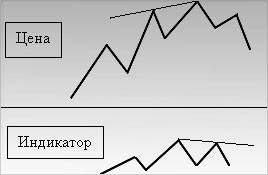
Fig.1. The schematic image of bearish divergence
If the prices fall to a new minimum and the indicator chart shows the rate higher than previous one, bullish divergence is formed (fig. 2).
Bullish divergence between the indicator and the prices denotes the descending tendency weakness and gives a signal of the growth beginning probability.
Indicator
Price

Fig.2. The schematic image of bullish divergence
Generally all indicators can be divided on two groups:
Trend indicators and Oscillators.
Let's consider indicators referred to trends.
The Moving Average indicator is the most frequently used indicator in the technical analysis. Moving average is counted within certain period. The less is period, the false signals are more probable. The more is period, the moving average sensitivity is lower.
Variants of moving averages:
1. Simple Moving Average.
2. Weighted Moving Average.
3. Exponential Moving Average.
Moving average value (MA) concerns a category of analytical tools which follow the tendency. Its purpose consists in defining of new tendency beginning time and also to warn about its end or turn. MA are intended for tendencies tracing in the process of their development, they can be considered as the curved trend lines. However MA is not intended for market movements forecasting as graphic analysis because it always follows the market dynamics instead of advances it. This indicator does not predict the prices dynamics but only reacts to it. It always follows the market prices movements and signals about the new tendency beginning but only after it has appeared. MA construction is a special method of price indicators smoothing. Really, at averaging of price indicators their curve considerably smoothes out, and it is easier to observe the tendency of market development. However already by the nature MA as though lags behind the market dynamics. Short-term MA transfers movement of the prices more precisely, than permanent long MA. Application short MA allows to reduce time lag, however completely to eliminate it by means of MA it is impossible. In the lateral markets it is more expedient to use short MA, and on trends is more effective long, as less sensitive.
Simple Moving Average
Simple MA or average arithmetic value is calculated by the following formula:
where Рi - the price of i-th day, n - an moving average order.
This type of MA is widely used by the majority of technical analysts. However some analysts dispute its advantages, putting forward thus two basic arguments. The first argument is that at the analysis takes into account the only time interval covered by this MA. The second argument is that the simple MA actually equalizes the each day prices importance. For example, at use of a ten-day moving average, the identical weight of 10 % is assigned to the last and first days, as well as to all other days of the period. Five-day MA, in turn, means that the day average price weight is equal 20 %. At the same time some analysts believe that later price indicator should have a greater value. This argument is quite logical, as at the new tendency simple MA is required more time for a turn and signal giving, than for weighed MA, considered below.
Weighted Moving Average.
To solve a problem of the prices average values "specific weight", some analysts use the weighed moving averages (WMA). They calculated by the following formula:
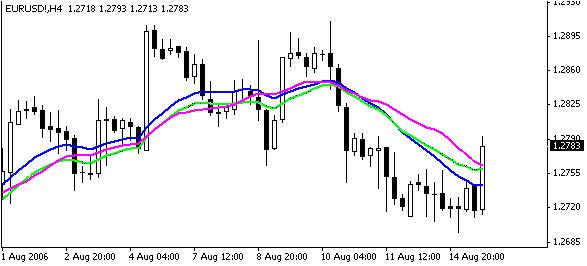
where Wi - weight of i-th component (price).
The weight, assigned to the prices in the above mentioned formula, can be chosen randomly. In general, the choice of prices weight depends on dynamics character of an investigated active. Weight can linearly increase, exponential or otherwise. In case of linearly-weighed MA Wi=i.
Exponential Moving Average.
Exponential Moving Average (EMA) has more difficult construction, than WMA or simple MA which allows EMA to eliminate two disadvantages of simple MA. First, EMA attaches much more importance to the last days’ indicators. Therefore it is weighed. But, though the smaller weight is given to the previous prices dynamics, at calculation all prices data for all period of equity market operation is used. The formula of this MA type calculation is more difficult and looks as follows:
EMAt=EMAt-1 +(k*(Pt - EMAt-1)),
where t-today's, t-1 - yesterday, k=2 / (n+1), where n - MA order.
Despite that EMA has no disadvantages, inherent simple MA, it is not best of three MA. Below thanks to testing efficiency of every MA will be shown.
Analysis rules.
The general rules of MA analysis are the following:
1.The most important signal showing a trend direction is the general direction of MA movement. At ascending MA it is necessary to adhere to the bull market and to work on increase. It is necessary to buy, when the prices will fall to MA, putting Stop Loss (SL) below the previous minimum, and to move it as soon as the prices will be closed above the previous level. At descending MA it is necessary to speculate for a fall, opening short positions when the prices will jump up to MA or slightly above. In that case SL should be placed slightly above the previous crest and dynamically to move it in case of the bear trend continuation.
2.The second signal is the intersection of MA and price graph. Such signal is strong for the outlined bull market if MA crosses the price chart on top with a positive incline, and the price chart also has the significant incline. In case of MA and the price chart intersection at a negative incline of the first and an insignificant positive or negative incline of the second, it is a weaker signal on outlined bull trend, and it is necessary to receive acknowledgement of future dynamics from an additional signal. There are similar signals for the outlined bear market, but with the inverse arrangement and MA inclination and price chart.
3. The third signal is the MA reverse at the minimum or maximum value. If MA is located under the price chart and has a local minimum and the price chart has a positive inclination the average force signal about the bull direction of the market and about upwards position opening; if the chart has no positive inclination, there is very weak signal for its confirmation it is necessary to use three additional signals. These rules may be used on the trend markets. On the market without revealed trend corresponding graph will have bends. Attempt to filter these bends mechanically leads, as a rule, to useful signal loss.

simple moving average
weighted moving average
exponential moving average
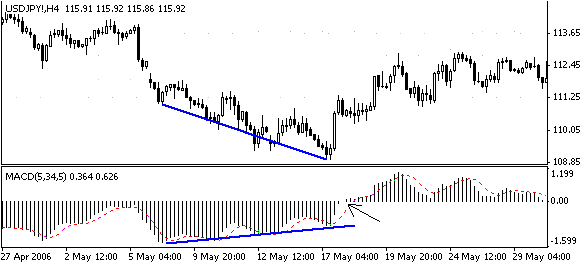
MACD (Moving Average Convergence/Divergence)
The moving average convergence/divergence (MACD) is a dynamic indicator following the tendency. It shows a correlation between two moving averages of the price. MACD indicator makes as a difference between two exponential moving averages (EMA) with the periods in 12 and 26 days on default. In order to identify favorable moments to buy or sell, the so-called signal line is put on the MACD graph - 9 EMA from MACD Line with smoothing by default 9.
At calculation of the histogram from EMA with smaller order (12) it is deducted EMA with the bigger order (26), and then from the received result 9-day EMA is deducted from difference EMA with order 12 and EMA with order 26:
MACD=EMA(P,12) –EMA(P,26) – EMA[(EMA(P,12) –EMA(P,26))9]
where P - price, EMA (P, n) - EMA with n order.
Obviousness and efficiency of this two MA analysis method permitted to win a great popularity among modern analysts. The best results MACD shows at its analysis on time intervals from day and more. It is necessary be more careful at MACD analysis on the less than day periods. The periods less than hour also contain information, but may include many false signals.
MACD is most effective in conditions when the market fluctuates with the big amplitude in a trading range. The most often used MACD signals - intersections, overbought/oversold conditions and divergences.
All MACD signals can be divided into three categories on degree of their value:
Trade on MACD intersections.
The simplest way of MACD usage is trade on its basic components intersections. Signals to buy are generated, when the histogram crosses zero line at the bottom and sell on the contrary. It is necessary to warn that in most cases mechanical trade on each MACD intersection gives frequent jerks that lead to considerable losses. It is necessary to avoid narrow trading ranges, effected destructive on the indicator. Try to buy, when the signal on buy is generated almost at zero line level. In most cases it is preceded by a strong bullish trend. If the similar signal is generated much lower reference line level the trend will be very weak. At the MACD histogram analysis it is possible to receive the additional information. So, if the bar (histogram column) is much lower reference line level and there comes a situation when each subsequent bar gradually decreases in size, it is necessary to take into consideration moment reduction. Reflecting the moment indicator, the histogram gives earlier signals.
Divergence.
Divergence is the second way of MACD usage. Divergence itself is a very effective form of the majority of technical researches and MACD is not exception. Divergence appears when direction of price movement is diametrically opposite to the direction MACD lines. Usage of this signal is more useful for indication of trend continuation after the correction than as a signal of trend reverse. Anyway, it is better not to run before the hounds but wait until the divergence reaches the steady states. Otherwise, you will feel worth if you turn out to be at the opposite side of the strong trend.
Overbought/oversold
The third variant of indicator MACD usage is market overbought/oversold analysis. This instrument allows with the specified degree of accuracy to set the points where market subjects to reverse. If MACD reaches the points of extremum placed at the opposite sides from the reference line, it means that market is oversold or overbought. Considering this type of signals, it is ought to set the points of extremum empirically; they can be different for each instrument.
When bar graph reaches these critical zone, any intersection with the signal line generates the signal for buying or selling. Intersections, which appeared before the level of extremum, can be ignored, so the majority of twitching will be avoided. Such levels can be determined as a result of simple investigation for any market which is in the wide trading congestion with the huge price fluctuations. Signals appeared at the medium zone of MACD graph can be accepted only if another proven indicator confirms that trading will being held along the trend direction. Obviously, such indicator is some oscillator. It should be remembered, that MACD is better used as a long-term instrument of following the trend, but not the short-term trading timer.

Pic. 4. Bullish divergence at the MACD predicted trend reverse, breakthrough of the null line gave the signal for buying.
ADX (Average Directional Movement Index)
The Average Directional Movement Index (ADX) is a Directional system (DS) which was developed by J. Welles Wilder in the middle of 70th and then was developed by some analysts. DS is used for determination of market trend forces. The rates of directional indicators (+DI and –DI) are used for calculation of ADX indications. For DS construction it is necessary to go through several steps:
- Determine the directional movement (DM) by comparison of current and yesterday’s price range, distance between the maximum and minimum. Directional movement is the major part of the current price range which is out of yesterday’s range.
- Determine the true range (TR) of the market. It is always positive number, maximum of three:
- Distance between the current maximum and minimum.
- Distance between the current maximum and yesterday’s closing price.
- Distance between the current minimum and yesterday’s closing price.
- Calculate the daily directional indexes (+DI and –DI). They help to compare different markets evaluating their directional movement as a percent of true range of every market. Every DI is positive number: +DI is equal to 0, if there is no directional movement downwards; -DI is equal to 0, if there is no directional movement upwards.


- Calculate the smoothed directional lines. Smoothed +DI and –DI are constructed with the help of EMA with exponent part 13. There appear two indicating smoothed lines: positive and negative. Correlation between the positive and negative lines determines the tendencies at the market. Basing on the made actions, we can calculate the ADX. This component of DS shows when it is better to follow the trend. ADX measures the scope between directional lines +DI and –DI. ADX is calculated by the following formula:
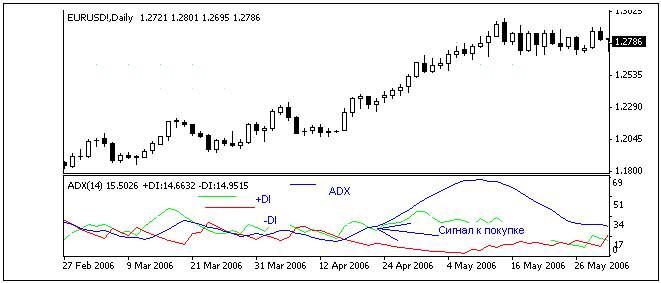
This index helps to estimate the strength of trend. If ADX rises, it indicates that market trend becomes stronger. At this time it is better to make deals only along the trend direction. When ADX falls, it means that trend is very weak. At this moment, signals given by oscillators have a great value. The role of directional analysis is tracing of changes in the mass optimism and pessimism estimating the capability of bulls and bears to take prices out of the previous days’ price range. If today’s maximal price is higher than yesterday’s one, then market becomes more optimistic. And vice versa, if today’s minimal price is lower than yesterday’s minimal one, then market becomes pessimistic.
During the DI analysis, the following signals appears:
- If +DI line is above –DI line, it indicates the general upwards dynamics of the trend. If +DI line is lower than –D line, then downtrend predominates at the market.
- If lines diverge, dynamics of trend gains strength, if lines converge, then trend weakens or prepares for the reverse.
There are several rules of trading using DS:
- Buy when +DI exceeds –DI, sell when –DI exceeds +DI. The most favorable conditions for buying are when +DI and ADX are above –DI, and ADX rises. It indicates the uptrend consolidation. And vice versa, it is better to sell when –DI and ADX are higher than +DI, and ADX rises.
- ADX decrease shows that market becomes less directed. When ADX goes down or pass under the both lines of DS, it means that market is calm. In this situations it is not recommended to use DS method.
Signal to buy

Pic. ADX graph rising confirmed the continuation of the uptrend which was indicated at the beginning by the ascent of +DI line, and gave a signal to buy.
Bollinger Bands
Bollinger Bands are similar to the moving average envelopes. However there is a difference between them: bounds of the envelopes are above and under the curve of moving average at the fixed, put into percentage distance, but bounds of Bollinger bands are constructed on the basis of distances which are equal to a certain quantity of standard divergences. The value of standard divergence depends on volatility, so bands control their width: it increases, when market is not stable, and it decreases at the stable periods. Bollinger Bands are usually drawn on the price chart, but they can be drawn on the indicator chart as well. Everything said below, applies to the bands drawn on the price charts. As in case with moving average envelopes, interpretation of Bollinger bands is based upon the fact that prices usually stay in the range of upper and bottom bounds of a band. Peculiarity of Bollinger Bands is their variable width conditioned by the price volatility. In the periods of considerable price changes (i.e. high volatility) bands widen giving the space for prices. In the periods of stagnation (i.e. low volatility) bands converge, keeping the prices within the bounds.
Peculiarities of Bollinger bands:
- Sudden price changes usually occur after the band’s stagnation indicating the decrease of volatility.
- If prices transcend the band bounds, then the current trend will continue.
- If after the peaks and cavities outside the band, the peaks and cavities inside the band follow, then the trend reverse is probable.
- Price movement started from one of the band’s bounds usually reaches the opposite bound. Last observation is useful for forecasting of the price targets.
Oscillators
Momentum and ROC
Oscillator Momentum estimates the value of price change for certain period.
Formula for calculation:
MOM = C – Cn
Rate of Change (ROC) is the second simplest type of oscillators' methods usage. Its difference from Momentum consists in calculation of its rate: it is estimated not as discrepancy, but as quotient from division of today’s closing price by the closing price x of days ago. General formula looks like:
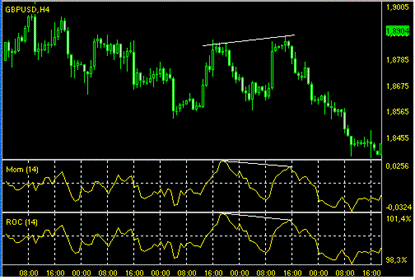
Pt – today’s closing price;
Px – closing price of x days ago.
Momentum and ROC look similar at the chart and apply almost equally. Difference is only in the scale of rates: there is number 50 in ROC at the place of 0 line, and instead of positive and negative values, fluctuation occur lower and upper of 50. Momentum and Roc determine acceleration of trend – speeding-up or speeding-down. These indicators have anticipating character, reaching the maximum before the trend reaches it, and minimum before the prices fall till their minimal level. While oscillators are reaching new maximums, it is safely to keep the long position and vice versa. Reaching more maximum, oscillator signals about the trend speeding-up, and most probably such situation will continue. When lower peak is reached, uptrend weakens and you should be ready to the trend reverse. Analogical reasoning does for minimums in the downtrend. Described above oscillators have the same disadvantages as simple MA – they react twice at the data of each day: when they enter the window, and when exit it.
When these oscillators reach new maximum, it indicates the increase of optimism at the market: prices most probably will rise. If prices go up, but oscillators’ rates go down, it means that the price maximum is coming and it is time to get profit from long positions and be ready for its reverse. There can be opposite situation too.
You should be very careful while using the leading indicators:
- Buy while uptrend when oscillator, having fallen below the zero line, starts to rise. This reflects slowdown of the trend. Sell while downtrend when oscillator rises above the zero line and then start falling.
- New indicator’s maximum indicates high bulls’ energy, owing to this the market may reach greater maximum. In this case you may hold long position with the relative safety. A number of the downwards maximums determines bulls’ mood weakening and the position should be immediately reversed. Opposite approach is used in case of downtrend.
- The change of the oscillator trend line often anticipates the change of the prices trend line for one-two days. That is why if the change of the leading indicator line takes place you should be ready to reverse the position. Oscillator reaches overbought state when it has reached higher level in comparison with the previous index. Overbought state shows extremely high level when oscillator is ready to turn down. Overbought state of the market is characterized by the situation when bulls do not want to buy or their opportunities to buy run out and they can not rise prices to the new high. At that period we may observe a slack and prices do not have severe bullish trend. Due to the fact that bulls can not rise prices to the new level and prices dynamics for n days has positive slope an oscillator turns down and after some time breaks the border of the oversold area. This is a signal that the trend will reverse. By analogy oversold state takes place when oscillator reaches low value towards the previous ones. Oscillator is ready to start rising. Overbought and oversold levers are indicated at the chats by horizontal supporting lines. The rule is to place oscillator so that it stays not more than 5% of time outside the zone limited by these lines. The lines should cross the highest tops and toughs of the oscillator for the last six months. Their position should be corrected every 3 months. Oscillator may stay in the overbought zone for several weeks when new uptrend starts and gives early signal to sell. When we have downtrend the oscillator stays in the oversold zone, mistakenly advising to buy. In such situations you should analyse trend indicators. As already described indicators the oscillators give the best signals when they are different from the prices. Bullish divergence takes place when prices rise up to the new top and oscillator does not change its position. Such situation shows that prices are rising by inertia and bulls are played out. There is opposite situation during bearish divergence. It should be mentioned that triple divergences are possible for oscillators and signals from such divergences are stronger.
The main methods of the speed oscillator usage:
- As oscillator which follows a trend like MACD. In this case a signal to buy occurs if an indicator forms a trough and starts to rise; signal to sell – when it reaches a top and turns down. For more detailed determination of the oscillator reverse moments it is possible to use its short moving average.
- Extremely high or low oscillator values presuppose the continuation of the current trend. Thus, if an oscillator reaches extremely high values and then turns down wу should expect further rise of the prices. But in any situation do not hurry to close or open position before the prices prove the oscillator signal.
- As leading indicator. This method is based on the supposition that the final stage of the uptrend is usually accompanied by the rapid prices’ growth (because everybody believes in the growth continuation), bearish market closing is usually accompanied by their rapid fall (because everybody tries to leave the market).
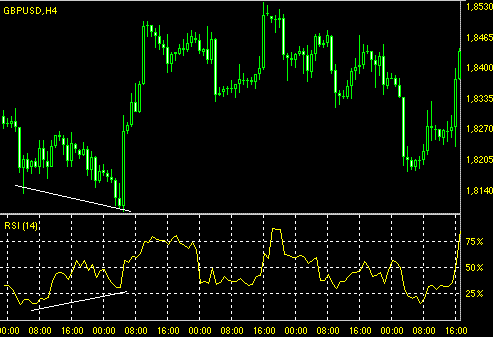
Pic.6 Registration MOM and ROC are very similar, the possibility of the direction change is determined after the upper borders of the interval are reached. Divergence became a strong signal for confirmation of the trend change.
RSI (Relative Strength Index) – is a financial technical analysis momentum oscillator measuring the velocity and magnitude of directional price movement by comparing upward and downward close-to-close movements. The RSI ranges from 0 to 100.One of the popular methods of RSI analysis lies in the search of divergence when a price generates new maximum and RSI does not manage to overcome the level of its previous maximum. Such difference indicates the possibility of the prices reversal. If RSI turns down and falls below its trough it completes “a failure swing”.
The failure swing is considered a confirmation of the impending reversal.
Ways to use Relative Strength Index for chart analysis:
1. Tops and bottoms
The Relative Strength Index usually tops above 70 and bottoms below 30. It usually forms these tops and bottoms before the underlying price chart;
2. Chart Formations
The RSI often forms chart patterns such as head and shoulders or triangles that may or may not be visible on the price chart; Failure swing takes place when RSI rises above the previous maximum or falls below the previous minimum.
3. Support and Resistance levels
The Relative Strength Index shows, sometimes more clearly than price themselves, levels of support and resistance.
4. Divergences
As discussed above, divergences occur when the price reaches a new maximum (or minimum) that is not confirmed by a new maximum (or minimum) in the Relative Strength Index. Prices correction takes place in the direction of the RSI.
In June 1978 Welles Wilder introduced the Relative Strength Index (RSI), which is a widespread oscillator. RSI is one of the most popular and famous among all oscillator methods. There is not only a standard oscillator analysis set, but also graphical analysis with the support, resistance and tendency lines, described above.
Formula for oscillator amount calculations is following:
RSI = 100 - [100/(1+RS)]; RS= AUx/ADx
X – the number of days;
AU – an average amount of the above closed prices for x days;
AD - an average amount of the below closed prices for x days;
This oscillator determines strength of bullish and bearish moods, tracing the price changes during this period. RSI situates in an area from 0 to 100. The two control levels (the higher bottom control level is above 70, the lower bottom control level is below 30) are put on the chart with the help of horizontal markers. However, some shift of the lines is possible at the strong trend markets: at the strong bullish markets they may be at the levels from 40 to 80, at the strong bearish markets – from 20 – 60. 3 signal types of RSI are known. These are divergence, chat models and levels.
Bullish divergence gives signals for buying. A bullish divergence occurs when the prices reach a new low but RSI does not. It is better to buy when RSI starts rising from this minimum and place stagnation point below the level of the last lowest price. The signal for buying will be especially strong if penultimate minimum RSI occurs under the lowest supporting line and last minimum above the line. In case of bearish divergence, we face reversed situation. Buy signal is strong if penultimate RSI top is above the top of the supporting line and the last top is under the supporting line. Among all indicators classical graphical methods work better exactly with RSI. Dynamic of the RSI chat advances prices dynamic for several days giving the material for building suppositions about their further behavior. Thus, trend line RSI is changing two days
before the price. The rules for analysis of the trend lines RSI are the following: when RSI chat breaks trend line RSI down directed from the bottom place a buy order, in the opposite situation, when RSI chat breaks trend line RSI up directed place a sell order. When RSI rises above the top support line we may speak about the bulls’ strength but at the same time such situation characterizes the market as overbought and ready for selling. On the contrary when RSI falls under the bottom support line we speak about the bears’ strength, the market is oversold and in some time traders start to buy. Holding long position backed up by overbought signals RSI is reasonable only if there is weekly uptrend. One important peculiarity connected with the oscillators usage should be mentioned.
Any strong trend directed down or up usually makes oscillators take critical values rather quickly. In such cases it is early to conclude that the market is overbought or oversold: such mistake may drive to the premature closing of the profitable position. For example, during the uptrend the market may remain overbought for a long period of time. However, if the oscillator value is in the top critical position it does not mean that you should eliminate all deals or open short deal during uptrend. The first appearance of the oscillator value in the overbought or oversold area usually is just a warning. More important signal which requires attention is the second appearance of the curve in the critical area. In case it does not prove the further rise or fall of the prices and oscillator curve forms double top or bottom we have to state possible divergence and take certain measures in order to protect positions. If a curve turns to the other side and breaks the level of the previous peak or fall it means that divergence signal is proved. In such situations it is worth using stop orders placing their levels right up close to the current prices level.
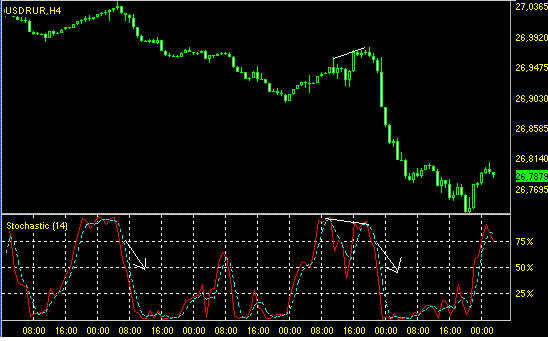
Pic.7 Indicator chat supported by the strong bullish divergence left overbought area and gave a signal to buy.
Stochastics Oscillator
Developed by George C. Lane in the late 1950s, the Stochastic Oscillator is one the most popular oscillators in the technical analysis. Oscillator is a curve fluctuating in the range of 0-100. It is considered that quotations are not stable if oscillator rises higher than 70 pips or fall below 30 pips. The stochastic oscillator buy signal is generated when it moves from below to above 20 percent and the sell signal is generated when it moves from above to below 80 percent. Sometimes simple moving average, drew at a chat of the stochastics oscillator. This is one of the most wide spread methods of the technical analysis. With the help of this method price moving with the selected period is revealed. Two simple moving averages: short and long are calculated and then average with the short period is deducted from the average with the long period.
Formula:
OSC = SMA(P,m) – SMA(P,n)
Actually, this formula shows a cross of moving averages and that is why this indicator may be rating as oscillator methods, however, one competent edition ranges it as oscillator. The authors think that using this indicator they eliminate all short-term prices fluctuations and long-term trends. For instance, while trading with one-hour prices’ fluctuations averaging in one hour is taken as a short period in order not to watch shorter fluctuations. Time lag of one day may be taken as a long period. Information about the average level which differs one day from another is lost. However, this disadvantage is compensated by indicator’s visualization. Positive overrated Oscillator values mean that the price is excessively increased towards long-term trend and give a signal to buy. High negative values signal to sell.
Classical Oscillator signals are bullish divergence and bearish convergence. The cross of the Oscillator of the zero line from the bottom is a signal to buy if it is a confirmed bullish trend (Oscillator reverse towards trend dynamics placed below zero line is considered to be the earliest signal). The cross of the Oscillator of the zero line from the top is a signal for buying if it is a confirmed bearish trend. The earliest signal is indicator’s reverse located above the zero line. This is a trend signal. Signals against trend –reverse of the Oscillator from the overbought and oversold areas. This indicator is based on the principle that during an upward trading market, prices tend to close near their high and during a downward trading market, price tend to close near their low. Stochastics compares current closing prices with recent low and high prices on a chart. The stochastics indicator is plotted as two lines, %K and %D. The second line is more important and according to its dynamic we may judge upon the most significant changes at the market. The %K line is more sensitive than %D . Mathematically, the %K line looks like this:
%K=100*[Ct-L5 / H5-L5]
C = the most recent closing price
L5 = the low of the five previous trading sessions
H5 = the highest price traded during the same 5 day period.
Formula allows to calculate the place of the last closing price for a certain period of time. If the value is above 70% then closing price is near the upper bound of the range is it is below 30% then closing price is near the lower bound. %D is 3-period moving average of %K.
The formula for the more important %D line looks like this:
%D=100 * CL3 / HL3 |
CL3 – three-day sum (Ct-L5);
HL3 – three-day sum (H5-L5).
According to the above formulas two lines are drawn which fluctuate from 0 to 100. K line is drawn as a continuous line and slower D line – dotted line.
Such stochastic lines are called fast. Some traders prefer to use slow stochastic lines. In this case formulas for both lines are changed. %К line is calculated according to the formula for %D, and %D as CC divided to %K. Stochastic oscillators shows the ability of the bulls or bears to close the market near the upper or lower range border. If bulls raise prices during the day but can not close them near maximum stochastic lines start to decrease. This gives a signal to buy. Divergence between the line %D and price which takes place when the line appears in the oversold or overbought area is a signal which you should pay attention at. These areas begin beyond the pale of the horizontal lines, which are determined by lines 70 and 30. The most important signals for buying or selling occur when the line В is in the area from 10 to 15 and from 85 to 90. Stochastic gives signal of three types:
- The strongest signals for buying or selling occur when the divergence takes place between the prices and indicators. Bullish divergence appears when line %D is above 70 and forms two falling tops and prices continue to rise. The line %D is under 30 and forms double upward bottom and prices continue to fall when we have bearish divergence. In case of existence of all these factors the final signal (to buy or to sell) is registered when K line crosses %D line – after the last one has already changed its moving direction. In other words, intersection should be on the right of the line %D extreme point. Thus, the signal to buy is more important in the bottom area, if the line K during its rise crosses the line %D after the line %D has already turned upwards. The signal to buy is more significant in the top area if the line %D reverses and starts moving downwards before K crosses it. The importance of intersection is higher if both lines move in one direction.
- Another signal is when an indicator occurs in the oversold or overbought area. If we have a weekly bullish trend and daily stochastic lines fall below the bottom line make a buy order establishing protective stop at the level of the previous button. For the opposite situation make order to sell. Stochastic lines extreme form very often allows to judge about the possible rise strength. In case of the narrow minimum the bears strength is low and we may expect strong rise. Opposite conclusions may be done in case the minimum is wide and deep. The same conclusions may be done regarding maximums of the stochastic lines.
- Next signal is the direction of the price chat and stochastic line ratio. Stochastic confirms short-term trends when both its lines have the same direction. Most probably that the upward trend will continue if both prices and stochastic rise. If the prices are moving and both stochastic lines rise short-term trend will very likely continue.
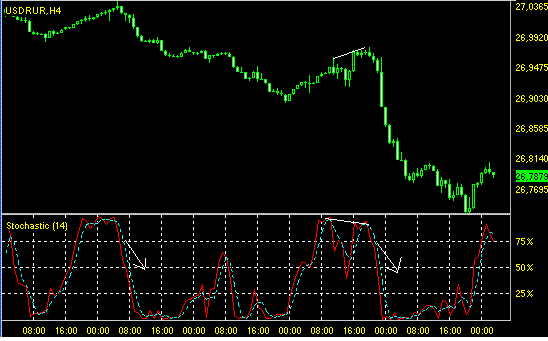
Pic.8 Pay attention how reliable stochastic indicates signals to buy for pair USD/RUR. The intersection of the line %D by the line %К and further moving downwards from the overbought area give perfect signals to buy (work only in the trend direction).
Helpful information for the users of the InstaTrader terminal
A number of indicators of the technical analysis are used by the program:
Average Directional Movement
One of the most frequently used technical indicators which allow to determine trend (tendency of the price change). J. Welles Wilder pays a lot of attention to this indicator in his book “New Concepts In Technical Trading Systems”.
Bollinger Bands
Bollinger Bands are an indicator that allows users to compare volatility and relative price levels over a period of time. A band plotted two standard deviations away from a simple moving average. Because standard deviation is a measure of volatility, Bollinger bands adjust themselves to the market conditions. When the markets become more volatile, the bands widen (move further away from the average), and during less volatile periods, the bands contract (move closer to the average). The tightening of the bands is often used by technical traders as an early indication that the volatility is about to increase sharply.
This is one of the most popular technical analysis techniques. The closer the prices move to the upper band, the more overbought the market, and the closer the prices move to the lower band, the more oversold the market.
Commodity Channel Index
This technical indicator is used for measuring price deviations of the financial asset from the average value. If index value is high, a price is considered to be overstated; if index value is low, a price is considered to be understated.
DeMarker
It shows the difference between the current and previous bar – if the maximum of the previous bar is higher the difference is registered, if maximum of the previous bar is lower or equal to the current maximum the difference remains zero. The DeMarker indicator fluctuates from 0 up to 100. The turn of the prices downwards is expected if the parameter of the indicator moves above a mark 70. The turn of the prices upwards is expected if the indicator moves below a mark 30.
Envelope
This indicator of the technical analysis is formed by the two lines of the moving averages, one is shifted upwards, another downwards. Moving Average Envelopes serve as an indicator of overbought or oversold conditions, visual representations of price trend, and an indicator of price breakouts.
Moving Average
Moving averages are one of the most popular and easy to use tools available to the technical analyst. Calculation of the moving average is made with the certain selected period. The more value of the period the least is the possibility of the false signals and sensitiveness of the moving average.
MACD (Moving Average Convergence Divergence)
A trend-following momentum indicator that shows the relationship between two moving averages of prices. The MACD is calculated by subtracting the 26-day exponential moving average (EMA) from the 12-day EMA. A nine-day EMA of the MACD, called the "signal line", is then plotted on top of the MACD, functioning as a trigger for buy and sell signals.
Momentum
This is a technical indicator that is designed to identify the speed (or strength) of a price movement. Usually, the momentum indicator compares the most recent closing price to a previous closing price, but it can also be used on other indicators such as moving averages.
Oscillator
Oscillator is calculated as the difference of the moving averages with the long and short periods.
Parabolic SAR
An indicator is built on the price chat. By implication this indicator is an analogue of the moving average, but PSAR moves with the greater acceleration and is able to change it position relative to the price. If a price crosses PSAR lines indicator’s turn takes place and next values of the indicator is placing opposite the price. Maximal or minimal price for the previous period will serve as the reference point. Indicator’s turn is a signal which indicates that a trend either stops or reverses.
Rate of Change (ROC)
The Rate of Change (ROC) indicator is a very simple yet effective momentum oscillator that measures the percent change in price from one period to the next. The ROC calculation compares the current price with the price n periods ago. Intervals from a minute to a month may be takes as periods.
Relative Strength Index
Indicator RSI is an indicator of the price change speed. This indicator is characterized by the price change for a certain period of time, it show the strength of the price. It calculates the average values of the price increase and decrease.
Standard Deviation
An indicator shows the strength of the price variability for a certain period of time. Standard deviation is calculated according to the simple formula: it is the square root of the variance.
Stohastic Oscillator
Stohastic Oscillator compares a current price with the price range for the certain period. Indicator is represented by two lines.
William's Percent Range
Williams’ Percent Range Technical Indicator (%R) is a dynamic technical indicator, which determines whether the market is overbought/oversold. It has an upside down scale.
For the most exacting technical analysis users the opportunity to export data for further analysis is foreseen in the specialized systems of the technical analysis Omega Tradestation and Metastock.
Test
- Give a definition of the technical indicator.
- What groups are technical indicators divided into?
- What signal is the most efficient (strong) in the technical analysis? Explain the structure of this signal.
- Describe trading signals of the Stohastic indicator.
- Under what MACD signals long positions should be opened?
- What does ADX chart show?
The list of the recommended literature:
 English
English  Arabic
Arabic  +971 4 32 87 555
+971 4 32 87 555 